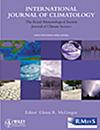Simple GCM Simulations of Rainfall Over Northeast Brazil, Part 2: Model Performance for Historical Seasonal Forecasts
Abstract
A dynamical model is used as a simple GCM to perform historical forecasts for rainfall in northeastern Brazil for the years 1982–2020. The model is forced by empirically derived source terms and includes basic parameterisations to simulate vertical diffusion, convection and condensation. Ensemble forecasts with 38 members are initiated on 1st January using persisted tropical sea surface temperature anomalies (SSTAs). Rainfall forecast performance is evaluated for the February–April (FMA) rainy season. The model reproduces the climatological precipitation in the specified Nordeste region with a mainly dry bias as the model rainfall maximum is displaced in the the northwest. Hindcasts for interannual rainfall anomalies correlate with observed values (r = 0.46) and model variance is weaker than observed. A further set of forecast experiments with SSTAs restricted to the three major ocean basins reveals that most of the forecast skill can be attributed to the Pacific, despite the model's greater sensitivity to Atlantic SSTAs. The sum of results from the three ocean basins is close to the full hindcast result. Finally, a set of 128 forecast runs with idealised SSTAs placed regularly within the tropics is carried out to calibrate the response of modelled rainfall to remote influences. An influence function is diagnosed in the form of a tropical distribution of northeastern Brazil rainfall in mm/day per unit SSTA. It is strongly concentrated in the tropical Atlantic, with dry/wet conditions resulting from positive SSTAs in the northern/southern tropical Atlantic, in keeping with the observed covariance. The influence function is the used to construct a linear approximation to the forecast performance of the simple GCM. It has similar skill but stronger variance, and the skill is partitioned differently between Atlantic and Pacific influences.

 求助内容:
求助内容: 应助结果提醒方式:
应助结果提醒方式:


